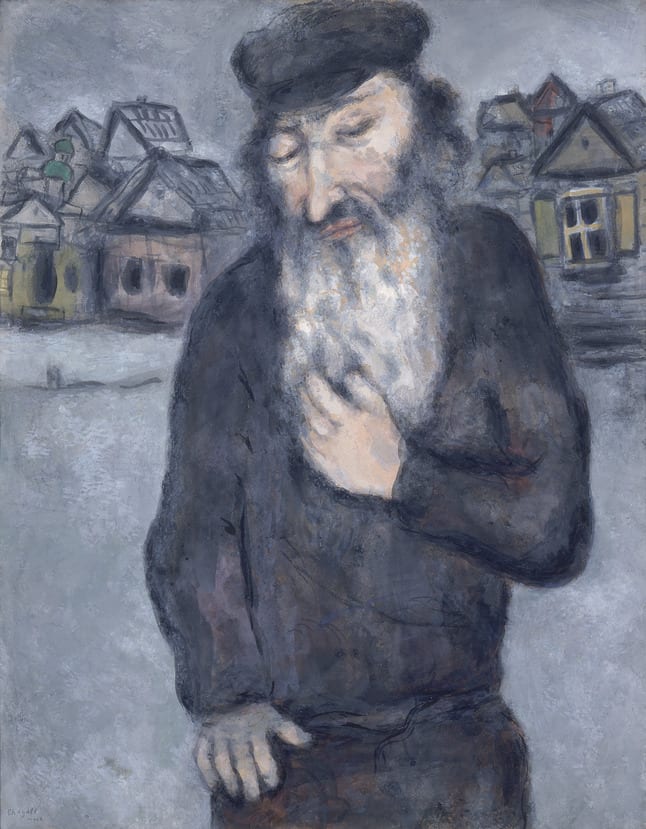
- Artist/Maker:
- Marc Chagall
- Bio:
- French, b. Belarus, 1887-1985
- Title:
- Untitled (Old Man with Beard)
- Date:
- c. 1931
- Medium:
- Gouache and watercolor over charcoal or graphite on paper
- Dimensions:
- 24 1/4 × 19 in. (61.6 × 48.3 cm)
- Credit Line:
- Gift of Frances Gershwin Godowsky and family in memory of George Gershwin
- Accession Number:
- 1999-77
- Copyright:
- © 2014 Artists Rights Society (ARS), New York / ADAGP, Paris
Not On View
Old Man with Beard depicts the outsize figure of a Jew standing alone in a snowy landscape before the backdrop of a Russian village. No one else can be seen, and there is not even a human footprint on the ground. The head is framed in the center of the canvas by the houses of the village. Wearing a Russian visored cap and dark caftan, the figure projects an aura of meditation. The depiction of a religious Jew derives from Chagall's store of images of Russian shtetl life. But the image is generalized and timeless without iconographic specificity and is rendered with a modernist vocabulary fused with folkloric elements and an odd disjunction of figure and houses behind. The remarkable dominance of the figure in the space, the tilt of the head, the hand gesture, and the houses that frame the head suggest that the artist continued to make use of various stylistic devices that he had employed previously.
Although this painting was created long after Chagall's departure from the Soviet Union in 1922, his fantasy world was occupied with the ordinary figures of Vitebsk. The old man with the beard in the Jewish Museum painting is a subject derived from one of the poor Jews whom he saw in Russia and used as models for his cycle of Old Jews. As Chagall states in "My Life," his models were old beggars or itinerant Hasidic rabbis. From chance encounters with beggars, peddlers, and itinerant Jewish preachers, Chagall conjures up the eternal figure of the migrant rabbis and Jewish miracle workers so prevalent in Eastern European Jewish communities. Often they were wandering Jews, filled with holy inspiration, proclaiming the word of God, and they seemed to resonate with a spiritual radiance. In Old Man with Beard, we are aware that the figure is not employed merely as an actor in a scene. Rather, the singular nature of the figure allows us to experience his profound humanity.
Although this painting was created long after Chagall's departure from the Soviet Union in 1922, his fantasy world was occupied with the ordinary figures of Vitebsk. The old man with the beard in the Jewish Museum painting is a subject derived from one of the poor Jews whom he saw in Russia and used as models for his cycle of Old Jews. As Chagall states in "My Life," his models were old beggars or itinerant Hasidic rabbis. From chance encounters with beggars, peddlers, and itinerant Jewish preachers, Chagall conjures up the eternal figure of the migrant rabbis and Jewish miracle workers so prevalent in Eastern European Jewish communities. Often they were wandering Jews, filled with holy inspiration, proclaiming the word of God, and they seemed to resonate with a spiritual radiance. In Old Man with Beard, we are aware that the figure is not employed merely as an actor in a scene. Rather, the singular nature of the figure allows us to experience his profound humanity.
Information may change as a result of ongoing research.